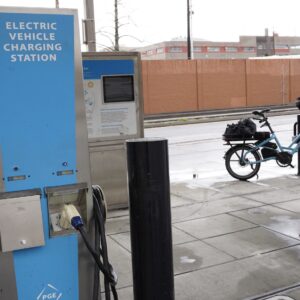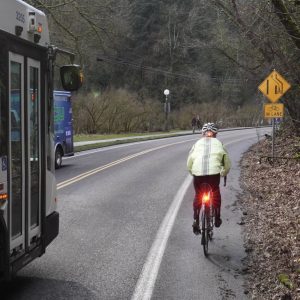“Over the past two years, actual contract costs have come in much lower than the estimates on which rates were based. These significant savings mean we can make these Green Streets investments without impacting rate payers.”
— Mayor Sam Adams
Last week, the City released the ordinance language behind Mayor Sam Adams’ plans to find $20 million to “kickstart” funding of the 2030 Bike Master Plan. According to the ordinance, the $20 million would be allocated from the capital project budget of the Bureau of Environmental Services and directed into bike boulevards via BES’s Green Streets program.
Also released last week was a memo from BES stating where the $20 million would come from. That memo grabbed a lot of headlines because it said the $20 million would come, in large part, from funds set aside to fix old, leaky sewer pipelines. As you can imagine, that idea rankled some Portlanders.
But, as Adams pointed out via Twitter yesterday, that memo was from BES, not the Mayor’s office. In response to an update I posted that linked to an article in the Tribune titled, Swap sewers for bikes?, Adams tweeted, “this is Saltzman’s bike funding $ list not mine. Mine tomorrow.”
So, just where will Adams’ promised $20 million come from? According to a statement from Adams’ office, he’ll bring a proposal to council Wednesday (3/10) that will “re-allocate a portion of the unused contingency and contract savings that have become available within the Bureau of Environmental Services as a result of the recession.”
That idea is not new. Adams mentioned it at the Council hearing on the Bike Plan back in February 11th. What is new are the specific details behind the idea.
In his statement today, Adams calls Green Streets funding a “double-win” for Portlanders because of how they treat stormwater and calm traffic (learn more about Green Streets in this video).
Here’s how Adams explains the contract savings:
“Over the past two years, actual contract costs have come in much lower than the estimates on which rates were based. These significant savings mean we can make these Green Streets investments without impacting rate payers. As a result, millions of dollars in contract savings give us the opportunity to reprogram funding for Green Streets investments.”
And here is Adams’ detailed list of funding sources that account for the $20 million for each of the next three years (through FY 2014):
Grey to Green – $3.0 million
This funding is already slated for city-wide green street projects. It would be redirected to Green Streets projects to enhance prioritized bicycle boulevards through 2014.Recession-related contractor bid/contingency savings – $15.4 million
As analysis from the City’s Office of Management and Finance shows, BES has experienced millions of dollars of contract savings over the past two years, providing the opportunity to reprogram funding for Green Street investments.1% for Green – $0.8 million
Water, BES and PBOT pay 1% of construction costs for projects in the public right of way which do not trigger the Stormwater Management Manual requirements. Some of this money currently funds green streets. This would redirect all of it through 2014.Innovative Wet Weather Grant $0.8 million
This is money received as a grant from EPA to build innovative stormwater facilities. Green Streets projects are an allowable use of these grant funds.Total – $20 million
Adams also released a matrix of BES and PBOT projects prepared by the Office of Management and Finance that detailed contract savings amounts.
This proposal will go in front of Council on Wednesday. More coverage in the Portland Tribune.







Thanks for reading.
BikePortland has served this community with independent community journalism since 2005. We rely on subscriptions from readers like you to survive. Your financial support is vital in keeping this valuable resource alive and well.
Please subscribe today to strengthen and expand our work.
Thanks Jonathan for this informative reporting.
It sounds to me like some people are getting riled up (or trying to rile people up) without knowing all the facts.
In a City that spends ALOT of time and resources PLANNING, I believe we need to support leadership that finds creative ways to IMPLEMENT those plans with projects that achieve multiple goals.
Linking investments in Bike Blvds and Green Streets is a good idea because they both directly and indirectly implement elements of both the Bike Master Plan AND the Portland Watershed Plan (and apparently also the Climate Action Plan).
Over the past two years, actual contract costs have come in much lower than the estimates on which rates were based. These significant savings mean we can make these Green Streets investments without impacting rate payers.
The problem with Adams’ statement, of course, is that he knows (a) we already pay some of the highest sewer rates in the nation, (b)sewer infrastructure is in sore need of basic repair (hence the allocated funds), and (c)rates are indeed rising, again.
Is stormwater management a good idea? Of course. Is repairing old, worn, basic sewer infrastructure a good idea? Yes–and critical, in fact.
The problem isn’t that it’s not clever to combine stormwater management with bike lanes–it’s that Adams and City Council have a fundamental problem and lack of skill in managing priorities. It’s a political game, for those paying attention. So, many (in fact, likely most) citizens, especially property owners, are upset that instead of taking care of basic needs, lowering rates, reducing debt and funding critical priorities, Adams is proposing to shift priorities (and funding) elsewhere, to support a pet idea. The end result? The opposite of vision and courage. It’s a shell game, being played right in front of you.
There is quite a large backlog of sewer projects that need this money. I don’t think he will be able to spend it on bicycles
As a home owner, landlord and daily bike commuter, I definitely have mixed feelings about the diversion of sewer fees to bicycle projects (as well as other projects, by the way). It may be a small victory for biking in the short run but result in a nasty backlash that scuttles the bike plan in the future.
The devil may be in the details of the green streets–which ones and where? If this money goes primarily to streets within three miles of downtown, which already is very bike friendly, then it’s going to be a big waste, especially by people further out.
The city needs to figure out other ways to fund the bike plan. A well-crafted bond measure–one that includes projects in various parts of town–would be more acceptable.
In a few weeks, I’m going to file my taxes and pay a hefty self-employment tax to Tri-Met. As mismanaged as that agency is these days, I’d much rather pay that fee to fund bicycle infrastructure.
This perfectly demonstrates the total lack of competence and integrity of Sam Adams and the City Council. There is no plausible connection between ANY transportation funding and sewer interests, regardless of any Greenwashing one tries to invoke. If the politicians want more transportation money, initiate a bond, or divert from already collected transportation monies. This is fiscal B.S. and unethical, and creates more reason for the general public to dismiss the bicycle community as a bunch of selfish jerks… something I don’t really appreciate as a daily commuter, ex racer, and general advocate of all forms of cycling. I’d frankly rather have the sewer system not pollute the river or back up into my house than have the PDX planners allowed to screw up the town more than they already have.
Don’t be suprised if in the end there will be a bicycle regestration fee, or some sort of mandatory bike chip/license that serves multiple uses. 1= collect revenue of coarse, 2= quickly locate stolen bikes, 3=??